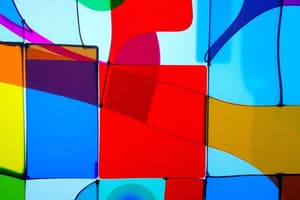Podcast
Questions and Answers
What is the chemical composition of glass?
What is the chemical composition of glass?
- Silicates, lime, and soda (correct)
- Silicates, calcium, and lead
- Silicates, iron, and lime
- Silicates, aluminum, and soda
What is the appearance of glass?
What is the appearance of glass?
- Translucent and colored
- Usually transparent (correct)
- Colored and opaque
- Opaque and translucent
When did glass container manufacture become mechanized in the United States?
When did glass container manufacture become mechanized in the United States?
- Early 19th century
- Late 20th century
- Mid 20th century
- Late 19th century (correct)
What are the two main types of glass containers used in food packaging?
What are the two main types of glass containers used in food packaging?
What is the historical significance of glass in packaging?
What is the historical significance of glass in packaging?
What is the chemical composition of glass?
What is the chemical composition of glass?
What is the historical significance of glass in packaging?
What is the historical significance of glass in packaging?
What led to the manufacture of hollow glass containers?
What led to the manufacture of hollow glass containers?
What is the appearance of glass?
What is the appearance of glass?
What is the scientific significance of the amorphous random distribution of atoms and molecules in glass?
What is the scientific significance of the amorphous random distribution of atoms and molecules in glass?
Flashcards are hidden until you start studying
Study Notes
Chemical Composition of Glass
- Glass is primarily composed of silica (SiO2), which constitutes around 70-75% of typical glass formulations.
- Additional components include soda (sodium carbonate, Na2CO3) and lime (calcium oxide, CaO) to enhance its workability and durability.
- Other materials such as alumina, potassium oxide, or magnesium oxide may be added for specific properties.
Appearance of Glass
- Glass is typically transparent or translucent, allowing light to pass through while being impervious to moisture and gases.
- It can have a smooth, glossy surface that reflects light but is also available in various colors and textures.
Mechanization of Glass Container Manufacturing
- The mechanization of glass container manufacturing in the United States began in the early 20th century, specifically around the 1900s.
- This innovation allowed for increased production efficiency, consistency, and lower costs compared to hand-blown techniques.
Main Types of Glass Containers in Food Packaging
- The two primary types of glass containers used in food packaging are soda-lime glass and borosilicate glass.
- Soda-lime glass is most common for food and beverage containers due to its affordability and ease of production.
- Borosilicate glass is more resistant to thermal shock and is utilized for items requiring heat resistance, such as laboratory glassware and certain food storage.
Historical Significance of Glass in Packaging
- Glass has played a crucial role in food preservation and packaging since ancient times due to its impermeability, recyclability, and inert nature, which doesn't react with contents.
- The use of glass containers has significantly impacted food safety, shelf life, and consumer trust, facilitating the global trade of perishable goods.
Manufacture of Hollow Glass Containers
- The development of hollow glass containers was driven by the need for efficient storage and transport of liquids and semi-solids, such as food and beverages.
- Advances in furnace technology and forming processes contributed to the shift towards hollow glass production.
Scientific Significance of Glass Structure
- The amorphous random distribution of atoms and molecules in glass results in unique properties, such as its rigidity and transparency.
- This structure contributes to the non-crystalline nature of glass, which allows it to withstand stress and changes in temperature without fracturing easily.
Studying That Suits You
Use AI to generate personalized quizzes and flashcards to suit your learning preferences.




